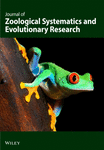Lethal genes in O5, chromosomes of Drosophila subobscura from Europe and America
Abstract
In populations of D. subobscura, a species that is know for its high chromosomal polymorphism, the O5 inversion has a rather erratic frequency distribution in the Palearctic region. An O5 lethal chromosomal line obtained from a Balkan population near Zanjic (South Adriatic, Montenegro, Yugoslavia) was tested for lethal allelism with other O5 lethal chromosomal lines derived from American (USA and Chile) colonizing populations, and from the French population of Taulé. No allelism was found between the Balkan lethal gene and those from America and France. Thus, the lethal genes of the O5 inversions are not of the same origin and it is most probable that the American colonizations did not start from the Zanjic population. The general difference in the chromosomal inversion polymorphism corroborates this conclusion. The cytological analysis confirms the assumption that all O5 chromosomes studied are identical with respect to breakage points.




